If you’re new to encaustic art, you may be wondering what it entails. Encaustic art, also known as wax painting, involves using heated beeswax to which colored pigments are added.
The mixture is then applied to a surface, such as wood or canvas, and fused with a heat source to create a beautiful and unique work of art.
Encaustic art has been around for centuries, dating back to ancient Egypt, Greece, and Rome. In recent years, it has experienced a resurgence in popularity thanks to the unique and versatile results it provides.
Key Takeaways:
- Encaustic art involves using heated beeswax to which colored pigments are added.
- Encaustic art has been around for centuries and is experiencing a resurgence in popularity.
- In this article, we will guide you through the basics of encaustic art, including techniques, essential supplies, and tips for getting started.
Getting Started with Encaustic Art
If you’re new to encaustic art, there are a few basic steps you need to follow to get started. Here are some tips on how to start with encaustic art:
- Begin by selecting your materials. As a beginner, you will need encaustic paint, beeswax, and a heat source like a hot plate or heat gun. You may also need brushes, surfaces to paint on, and other supplies specific to your project.
- Prepare your workspace. Encaustic art involves melting wax, so make sure you have a well-ventilated area with a flat surface to work on. Cover your work area with materials like aluminum foil or newspaper to keep it clean.
- Start experimenting. Once your materials are set up, start playing around with the wax to see what works and what doesn’t. Try layering colors and techniques like fusing to get a feel for the medium.
Encaustic art is a versatile medium that offers a wide range of creative possibilities. Here are some tips and techniques to help you explore the full potential of encaustic painting:
- Layering: Build up layers of wax to create depth and complexity in your artwork. Experiment with different colors and textures to achieve the desired effect.
- Carving: Utilize carving tools to etch lines and patterns into the wax. This technique is great for adding intricate details and texture to your encaustic artwork.
- Image transfer: Transfer photographic images onto your wax paintings using transfer paper or collage techniques. This technique is an excellent way to incorporate visual interest and narrative elements into your art.
- Collage: Combine different materials such as paper, fabric, and found objects with encaustic wax to create mixed media artwork with unique textures and depth.
- Texture: Experiment with various tools and techniques to create texture in your encaustic paintings. Use tools such as palette knives, heat guns or blowtorches to create ridges and peaks on the surface of the wax.
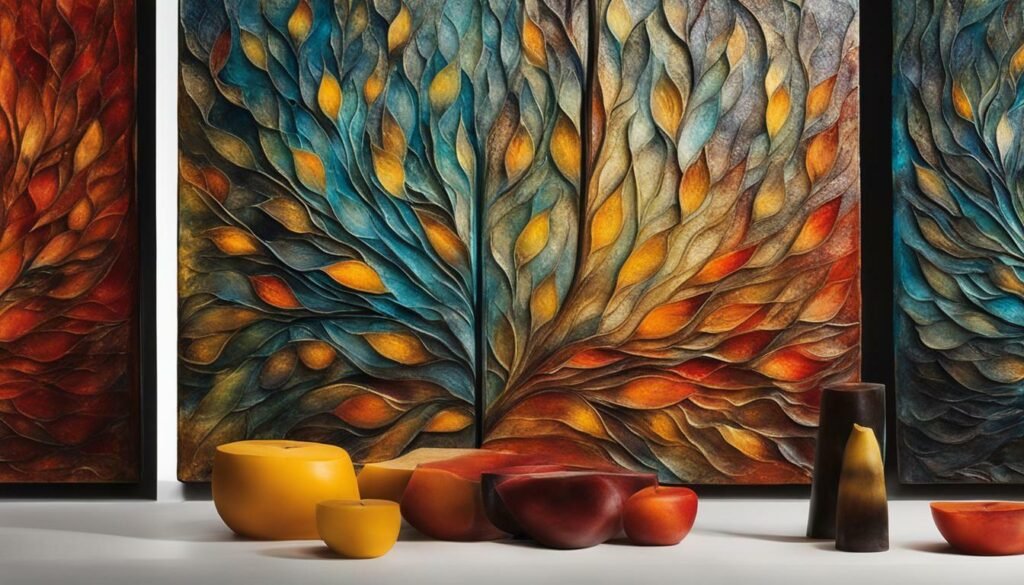
Essential Encaustic Art Supplies
To create stunning encaustic art, you’ll need the right supplies. Here are some essential encaustic art supplies to get you started:
- Encaustic Wax: This is the primary medium used in encaustic art. It is a blend of beeswax and damar resin that provides a lustrous finish to your artwork.
- Pigments: Pigments are added to the wax to create color. Use high-quality pigments for vibrant and long-lasting results.
- Heat Tools: You’ll need a heat gun and/or a torch to heat and melt the wax, as well as a hot plate or griddle to heat your palette.
- Brushes: Natural bristle brushes are recommended for encaustic painting as they can withstand the heat and wax. You’ll need a variety of brush sizes and shapes to create the desired effect.
- Substrate: The surface on which you paint is called the substrate. Common options include wood panels, canvas, and paper. Choose a substrate that is sturdy enough to withstand the heat of the wax.
- Palette: You’ll need a non-porous surface to mix your pigments. A heated palette such as a hot plate or griddle is recommended as it keeps the wax at a consistent temperature.
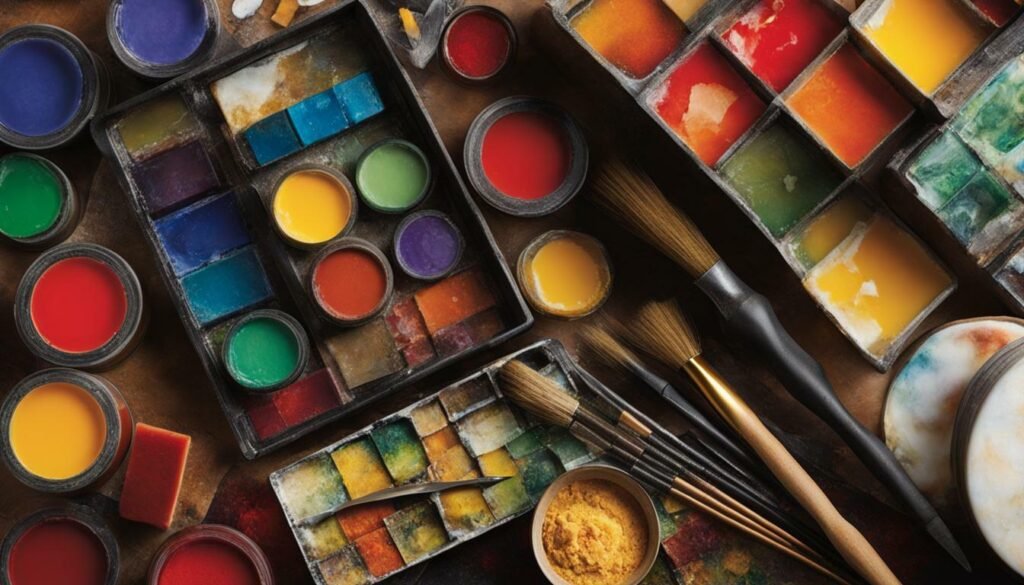
Before beginning your encaustic art practice, it’s essential to create a workspace that is safe and organized. Follow these tips to ensure a smooth and enjoyable creative process:
- Choose a well-ventilated, clean area to work in.
- Ensure that there is ample space for your materials and tools.
- Use a heat-resistant surface such as a griddle or hotplate as your work surface.
- Keep a fire extinguisher nearby in case of any accidents.
- Wear protective gear such as gloves and a respirator while working with encaustic materials.
- Keep your supplies organized and within reach to avoid any accidents or spills.
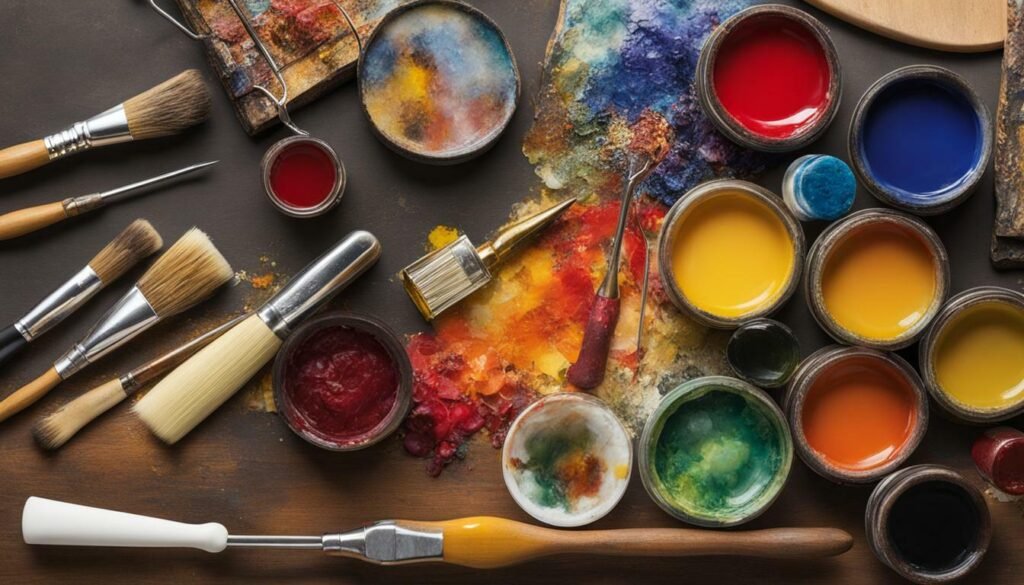
Basic Techniques for Encaustic Art
If you’re new to encaustic art, it’s important to learn the foundational techniques to create beautiful wax paintings. Here are some basic techniques to get you started:
- Fusing: The process of using a heat source, such as a heat gun or torch, to melt and blend layers of wax together.
- Layering: Building up layers of wax to create depth and texture in your artwork.
- Creating Texture: Using tools such as brushes, palette knives, and even everyday objects like credit cards to create unique textures in the wax.
By mastering these techniques, you can bring depth and dimension to your encaustic art.
Another important technique is creating a smooth surface. It’s essential to keep your painting surface smooth to avoid bumps and lumps in the wax.
Apply a thin layer of wax to the surface and use a heat gun to melt and smooth out any bumps or rough spots. Repeat this process until you achieve a smooth surface.
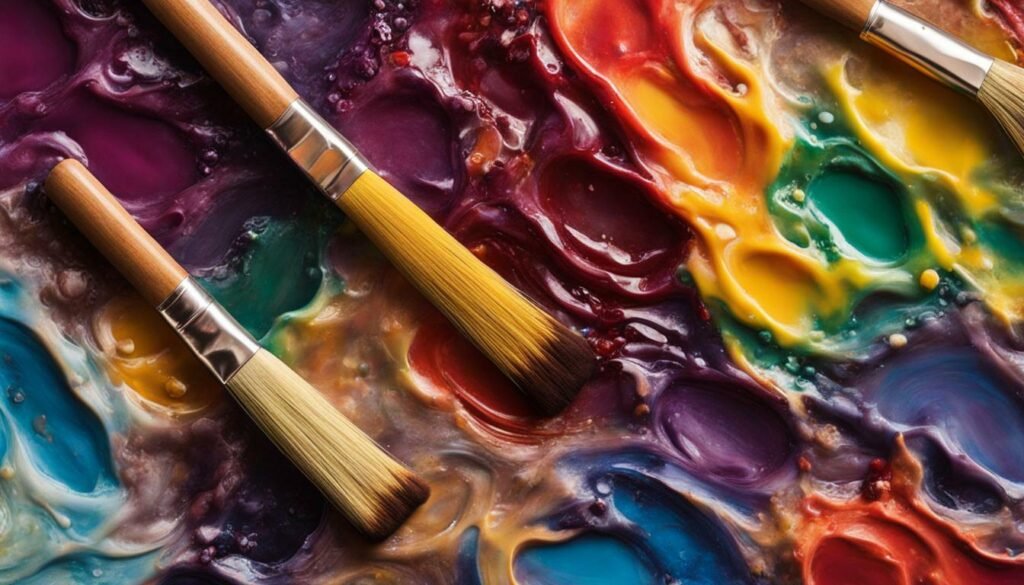
Exploring Color in Encaustic Art
Color is a crucial element in encaustic art as it helps create mood, atmosphere, and depth in your artwork. Mixing pigments with melted wax is the most common way to add color to your encaustic painting. Here are some tips for exploring color in encaustic art:
- Start with a limited color palette and gradually add more colors as you become more comfortable with mixing and layering.
- Experiment with different color combinations to create balance, contrast, and harmony in your artwork.
- Use pigments with high-quality lightfast properties to ensure the longevity of your artwork.
- Consider using metallic pigments and adding gold or silver leaf for added texture and shine.
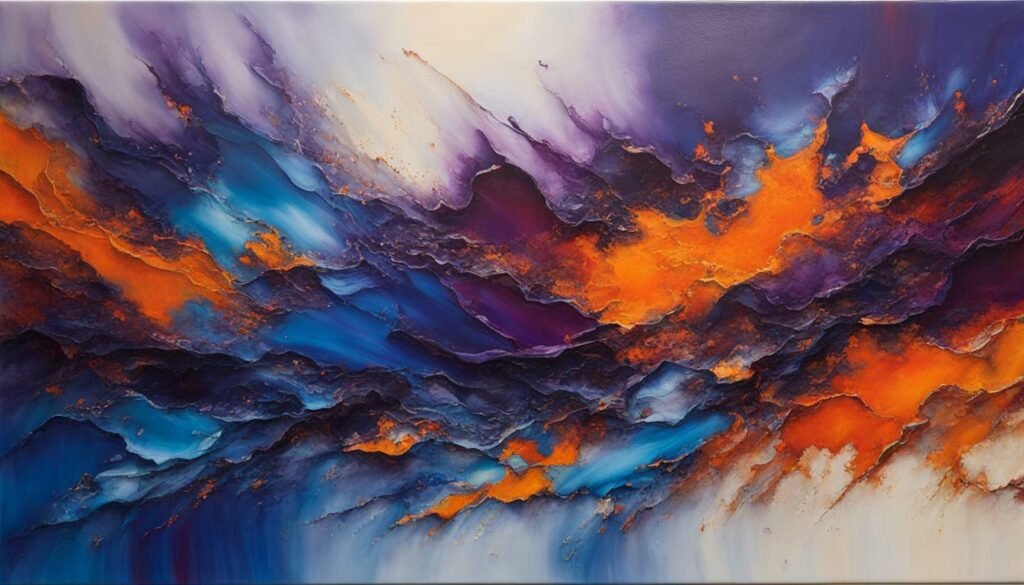
If you’re looking to add unique images to your encaustic art, image transfer techniques are a great way to go. Here are some encaustic art techniques and tips for transferring images:
- Collage: One of the easiest and most straightforward methods for transferring images onto your encaustic artwork is through collage. Simply select the image(s) you want to use, cut them to size, and place them onto the wax surface before fusing them in place.
- Image transfer sheets: Another option for transferring images is through the use of image transfer sheets, which allow you to transfer any image directly onto your encaustic painting. Print your desired image onto the transfer sheet and then follow the instructions to embed it into your wax surface.
- Freezer paper transfers: This is a popular encaustic art technique for transferring images onto your artwork. Print your desired image onto a sheet of freezer paper and then iron it onto your wax surface. After a few seconds, the wax will absorb the ink, and you can remove the paper backing to reveal the transferred image.
Encaustic art is a versatile medium that can be combined with other materials to create unique mixed media pieces. The possibilities are endless when it comes to mixing encaustic with other materials, so let your imagination run wild.
Here are some ideas to get you started:
- Paper: Incorporate paper into your encaustic art by layering it into your painting. Consider using tissue paper, book pages, or handmade paper for added texture and interest.
- Fabric: Add fabric elements to your encaustic art by fusing them onto your painting or incorporating them into a collage. Consider using lace, silk, or even old clothing for a unique touch.
- Found objects: Incorporate found objects into your encaustic art to give it a unique, three-dimensional quality. Consider using natural elements like leaves, stones, or twigs, or repurposing items like old jewelry or metal scraps.

To bring depth and tactile qualities to your encaustic artwork, creating texture is a must. Explore a range of techniques to enhance your wax paintings:
- Add texture by carving or incising into the wax layers before they cool.
- Use embossing tools or other objects with texture to create patterns.
- Apply wax with a palette knife or other tool to create raised areas on the surface.
- Use a heat gun or torch to create cracks and fissures in the wax layers.
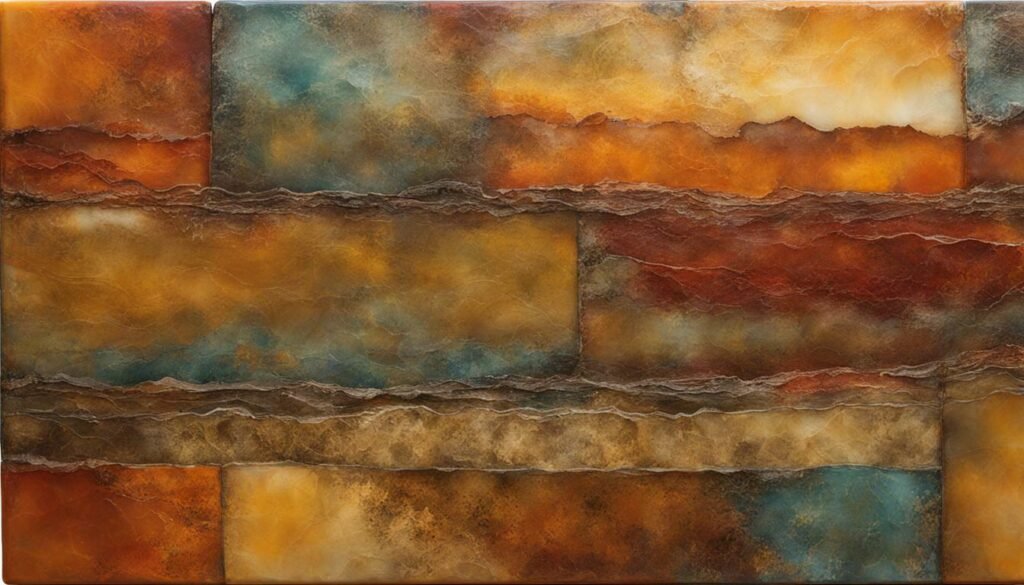
Finishing and Preserving Your Encaustic Artwork
Congratulations on creating your stunning encaustic artwork! To ensure its longevity, it’s important to properly finish and preserve it. Here are some essential tips:
- Allow your artwork to cool completely before handling it.
- Buff and polish the surface of your artwork with a soft cloth to create a smooth and luminous finish.
- Frame your artwork to protect it from dust and damage. Choose a frame that complements your artwork and consider using UV-protective glass or acrylic.
- Store your artwork in a cool, dry place away from direct sunlight and extreme temperatures.
If you want to take your encaustic art skills to the next level, joining encaustic art workshops and communities is a great way to do so. Here are some benefits:
- Gain new techniques and insights from experienced encaustic artists
- Connect with like-minded individuals who share your passion for wax painting
- Get feedback on your artwork and improve your skills through critiques and discussions
- Discover new sources of inspiration and ideas for your encaustic artwork
Ready to create your own encaustic masterpiece? Follow our step-by-step tutorial to achieve stunning results.
- Gather your supplies: encaustic wax, a heat gun or torch, painting supports, and pigment.
- Prepare your workspace: ensure proper ventilation and organize your materials.
- Begin by melting your encaustic wax in a pot or on a hot palette. Use a heat gun or torch to melt the wax onto your painting support, creating a smooth and even layer.
- Add pigment to your melted wax and mix thoroughly.
- Apply the pigmented wax onto your painting support, layering to create depth and texture.
- Use a heat gun or torch to fuse the layers of wax together, creating a cohesive and unified surface.
- Experiment with other encaustic techniques, such as carving, incising, or transferring images onto your painting.
- Finish your encaustic artwork by polishing and buffing the surface, or framing it for display.
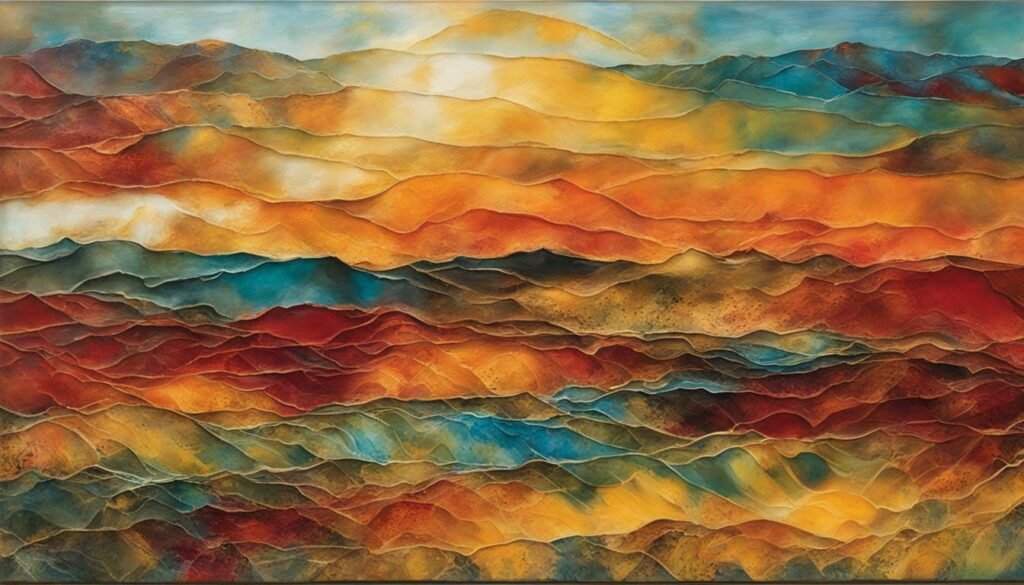
Encaustic Art Ideas and Inspiration
Looking for creative inspiration for your encaustic art? Here are some ideas to get you started:
- Experiment with abstract designs using bold colors and expressive brushstrokes.
- Create landscape scenes by layering various shades of wax to mimic the natural colors and textures of the outdoors.
- Add dimension to your artwork by incorporating found objects such as seashells or twigs into your encaustic painting.
- Explore the beauty of the human form by creating encaustic portraits or figurative art.
- Use stencils or image transfer techniques to incorporate intricate patterns or designs into your wax paintings.
- Experiment with different textures by carving or scraping into the wax to create unique surface effects.
- Combine encaustic art with other mediums such as photography, printmaking, or mixed media to create visually striking compositions.
FAQs
What is encaustic art?
Encaustic art is a painting technique that involves working with heated beeswax mixed with colored pigments. It offers a unique and versatile medium for creating stunning artwork.
What are some basic encaustic art techniques?
Some basic encaustic art techniques include fusing layers of wax, creating texture using heat tools or carving, and incorporating mixed media elements for added interest.
What supplies do I need to start with encaustic art?
To start with encaustic art, you will need encaustic wax, various pigments, brushes, heat tools, and a suitable surface to work on, such as a wooden panel or specialized encaustic paper.
How do I prepare my workspace for encaustic art?
It is important to create a safe and organized workspace for encaustic art. Ensure proper ventilation, keep flammable materials away from heat sources, and have a designated area for your supplies and tools.
Can I combine encaustic art with other mediums?
Yes, encaustic art can be combined with other mediums to create mixed media artwork. You can incorporate elements such as paper, fabric, or found objects to add texture and interest to your encaustic pieces.
How can I create texture in encaustic art?
There are various techniques you can use to create texture in encaustic art, including embossing, carving, incising, and applying different layers of wax to achieve a three-dimensional effect.
How do I finish and preserve my encaustic artwork?
To finish and preserve your encaustic artwork, you can buff and polish the surface, frame it using a protective barrier, and ensure proper storage to prevent damage from temperature fluctuations.
Are there any encaustic art workshops or communities I can join?
Yes, there are encaustic art workshops and communities where you can connect with fellow artists, learn new techniques, and gain inspiration. These workshops can be a great way to enhance your skills and expand your artistic network.
Can you provide a step-by-step encaustic art tutorial?
Yes, we have a detailed encaustic art tutorial that will guide you through the process of creating a stunning wax painting. Follow along with the instructions and helpful tips to bring your creative vision to life.
Where can I find encaustic art ideas and inspiration?
You can find encaustic art ideas and inspiration from various sources, including renowned encaustic artists, galleries, museums, art books, and online platforms. Exploring different themes and techniques can spark your own artistic exploration.
